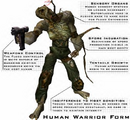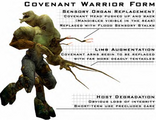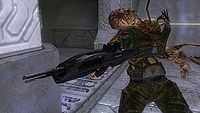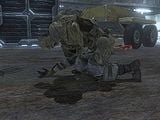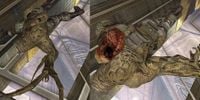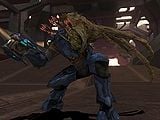Flood combat form: Difference between revisions
From Halopedia, the Halo wiki
SPARTAN-347 (talk | contribs) No edit summary |
|||
| Line 22: | Line 22: | ||
==Pathology== | ==Pathology== | ||
When an infection form successfully enters a host body, it takes over the organism's nervous system and mutates its body using [[LF.Xx.3273 Flood Super Cell|Flood Super Cells]] | When an infection form successfully enters a host body, it takes over the organism's nervous system and mutates its body using [[LF.Xx.3273 Flood Super Cell|Flood Super Cells]];<ref name="bestiarum">'''[[Bestiarum]]'''</ref> inhalation of [[Flood spore|spores]] can have the same effect. During the infection process, the host's internal organs are broken down, and the resultant nutrient stockpile is used to develop the tentacles, claws and various other appendages and apparatuses. Combat forms can spread the Super Cell merely through wounding a victim, though such infection may progress gradually.<ref>'''Halo: Evolutions - Essential Tales of the Halo Universe''' - ''The Mona Lisa''</ref> | ||
Both living and deceased hosts can be infected, although the infection process is inherently fatal to living hosts. If the host is still living when initially infected, or at the very least has not suffered somatic brain cell death, the Flood is able to retrieve comparatively vast quantities of information from the hosts memory; including specific coordinates, access codes, flight protocols, etc.<ref>'''[[Halo Graphic Novel]]''', ''[[The Last Voyage of the Infinite Succor]]''</ref> . Once it has total control over the host's corpse, the infection form changes the physiology of the body to better suit its own needs. As combat forms retain most of the host's abilities they are able to utilize their host's weapons and vehicles, albeit with less finesse. | Both living and deceased hosts can be infected, although the infection process is inherently fatal to living hosts. If the host is still living when initially infected, or at the very least has not suffered somatic brain cell death, the Flood is able to retrieve comparatively vast quantities of information from the hosts memory; including specific coordinates, access codes, flight protocols, etc.<ref>'''[[Halo Graphic Novel]]''', ''[[The Last Voyage of the Infinite Succor]]''</ref> . Once it has total control over the host's corpse, the infection form changes the physiology of the body to better suit its own needs. As combat forms retain most of the host's abilities they are able to utilize their host's weapons and vehicles, albeit with less finesse. | ||
Revision as of 17:07, October 10, 2012
| This article does not have enough inline citations and/or does not adhere to the proper citation format. You can help Halopedia by adding citations. |
Template:Flood Species Infobox A Flood combat form[1] is the product of Flood Super Cells, typically via an infection form, infecting a sentient host organism. They serve as the Flood's primary combatants, defending the Flood against attack and securing additional hosts for infection.
Pathology
When an infection form successfully enters a host body, it takes over the organism's nervous system and mutates its body using Flood Super Cells;[2] inhalation of spores can have the same effect. During the infection process, the host's internal organs are broken down, and the resultant nutrient stockpile is used to develop the tentacles, claws and various other appendages and apparatuses. Combat forms can spread the Super Cell merely through wounding a victim, though such infection may progress gradually.[3]
Both living and deceased hosts can be infected, although the infection process is inherently fatal to living hosts. If the host is still living when initially infected, or at the very least has not suffered somatic brain cell death, the Flood is able to retrieve comparatively vast quantities of information from the hosts memory; including specific coordinates, access codes, flight protocols, etc.[4] . Once it has total control over the host's corpse, the infection form changes the physiology of the body to better suit its own needs. As combat forms retain most of the host's abilities they are able to utilize their host's weapons and vehicles, albeit with less finesse.
On rare occasions, weak or damaged infection forms cannot properly take over a host, allowing the host to survive, even retaining some control and consciousness, as in the case of Private First Class Wallace Jenkins.[5]
In the initial stage of a Flood outbreak, the Feral Stage, combat forms communicate using pheromones and have one instinctual behavior: to secure new hosts to strengthen the local controlling intelligence. It is to be noted that a group of Flood will occasionally go after Sentinels if they are perceived to be the greatest threat in an area, even though Sentinels are unable to be infected by the Flood due to their inorganic nature.
Once a sufficient store of biomass is available the Flood enters the Coordinated Stage, and begins forming pure form Flood, with the combat forms being used either as defensive units or calcium/biomass reserves.
Infected hosts are rapidly digested while being converted, which leaves the host severely ravaged and decayed, much like a corpse that had been exhumed a few weeks after its burial.[6] Flood infection is a rapid and efficient biological process, as it can take under a minute in certain cases.[7]
Types of combat forms
Virtually any creature can be infected to become a combat form, but the most frequently-used hosts are Sangheili, humans and Jiralhanae. Unggoy and Kig-yar can also be infected, but are rarely seen as combat forms. A small number of species are known to be immune to conversion, including the Mgalekgolo/Lekgolo (which are composed of boneless worms and are only sentient as a collective), the Yanme'e, whose exoskeleton lacks the required amount of calcium which renders infection impossible, and the Huragok which is an artificial organism, and therefore believed to be immune.
All victims of the Flood's infection, regardless of their physiology, will undergo a similar mutation process. The skin decays rapidly, and changes to the texture of Flood biomass as the Flood Super Cell overtakes the body. The host's arm bones elongate and grow into whip or claw-like appendages, which will serve as their primary melee weapon in close-combat situations. As the Infection form now serves as the host's "brain", the head is usually forced aside, and can be severed without any effect on the combat form.[notes 1]
Human form
The human combat form is significantly smaller than other forms due to their original smaller size. As with other combat forms, it is capable of sustaining massive physical damage before being unusable to the Flood controller; in fact, as long as the chest cavity and legs remain intact, it will continue to fight. Although it cannot take as much damage as the Sangheili combat form can, the human form has some advantages. It seems to be more alert and is quicker to melee an opponent. It also presents a smaller, harder target to hit, especially the infection form, as it isn't protruding out of the body as much as those of Sangheili forms, not to mention due to the humans' preference for group-tactics, human combat forms are rarely encountered alone.
Spartan form[notes 2]
Flood-infected Spartans bear several differences from standard human combat forms. The right arm is converted into a pincer-like, bladed appendage, and the left leg sustains similarly drastic mutations. Exposed parts of the body are covered with what appear to be calcareous plates, and red "muscle" tissue can be seen in the gaps between plates. Perhaps because of the obstructing suit or armor plates, the typical Flood sensory tentacles do not protrude from the chest cavity. The form appears to retain more of its original silhouette than typical combat forms.
Sangheili form
The Sangheili combat form is a formidable enemy as it is very agile, resilient, and capable of utilizing its host's armor abilities such as active camouflage and energy shields to assist them in combat. The Sangheili combat forms are slightly larger than the human form and as such present a larger target.
Jiralhanae form
The Jiralhanae combat form is a formidable enemy and is more aggressive in combat than other combat forms, as it will charge towards an opponent recklessly; this behavior is most likely a result of the Jiralhanae's savage nature and preference for close combat. The Jiralhanae form is more powerful than the human form, but falls short against the Sangheili form. It is bulkier and slower than other combat forms. Since a a Jiralhanae cannot be infected until their power armor is destroyed, the Jiralhanae form cannot make use of their host's armor abilities.
Unggoy and Kig-yar combat forms
These forms do not appear in the trilogy and are instead introduced in Halo Wars.[notes 3] Rarely seen in actual combat situations, infected Unggoy and Kig-yar are more commonly converted into carrier forms or processed for their biomass. These "building blocks" can be used to add to a Gravemind's superstructure or be molded into Flood pure forms.
Unggoy and Kig-yar combat forms have only been witnessed in the first recorded contact between the Covenant and the Flood.
Anti-Flood countermeasures
- Combat Forms can take extensive and sizable amounts of damage before being neutralized. Arms, legs and even heads can be dismembered before they are incapacitated. The weak areas of a Combat Form are its sensory appendages that normally develop on the upper chest. This is where the Infection Form has nestled, and the body is incapacitated if this area is destroyed by a projectile weapon.
- In Halo: Combat Evolved, a combat form may fall only to stand up again and keep fighting. This can only happen if it is not damaged enough. In Halo 2 and Halo 3, if the body is not destroyed, Combat Forms can be revived if another Infection Form crawls into it.
- Human weapons are generally more effective against the Flood, as Covenant plasma weaponry is designed to debilitate targets by causing burning pain and structural damage to bodies, and the Flood cannot feel pain or be crippled.[8] However, In Halo 3, plasma-based weaponry and melee attacks, formerly weak against the Combat Forms in the previous two games, are now highly effective. Piercing weapons such as the Sniper Rifle and the Beam Rifle have little effect on Combat Forms. At a distance, explosive ordnance such as grenades and ranged weapons such as the Battle Rifle or the Covenant Carbine can perform well against Combat Forms. Do note that Plasma and Spike grenades should be used with caution, as the Combat Form will sometimes ignore all other targets and charge players using such weapons at high speed. The Needler can be devastating, as the supercombine explosion will prevent it coming back to life in Halo: Combat Evolved, and will shatter it in Halo 2 and 3. In addition, the Needler's explosions will destroy an entire horde of charging Flood Combat Forms, similar to grenades and rocket launchers. For ranged weapons, it is recommended for players to focus their fire at the sensory appendages that are visible on Combat Forms as successfully firing at one will immediately bring down a Combat Form. Dismemberment with ranged weapons is also recommended to prevent Combat Forms from firing their held weapons. At close combat, it is recommended that individuals acquire close-quarters weapons such as the Shotgun, Energy Sword and Gravity Hammer as they perform exceptionally well against Combat Forms. Burning Combat Forms with sufficient amounts of heat is one of the most effective methods in any situation, as is the destruction of the torso. Automatic weapons are also effective.
Trivia
General
- In Halo: Combat Evolved, combat forms will not disintegrate from successive melee hits when they are dead like in Halo 2 and Halo 3.
- In Halo 2, all Combat Forms are also capable of driving and boarding vehicles and are able to do so in Halo 3, though the ability to drive vehicles is lost. They still retain the ability to board slow moving vehicles however.
- In Halo 2, all of the Sangheili forms encountered use one armor palette; the Minor Combat Harness. In Halo 3 however, the Sangheili Forms will retain its host's armor palette. Strength of each Sangheili Form will be dependent on the ranks of its host; an infected Sangheili Major will be considerably harder to kill than a Sangheili Minor. Killing a Sangheili Combat Form is easier than a Human Combat form, a shot from a Carbine or Battle Rifle will take one down immediately.
- Flood Combat Forms seem to take on physiological and biological changes throughout the Halo trilogy; these changes from game to game could be due to the Gravemind's influence in attempting to create a better Flood soldier or they could simply be graphical updates.
- In all of the Halo games, Flood Combat Forms always hold certain two-handed weapons with one hand, and can actually reload them without doing a reload animation. These weapons include the Shotgun, the Rocket Launcher, the Assault Rifle and others. They can also use the Magnum with one hand and reload it without doing any animation for it.
Halo: Combat Evolved
- Combat forms will run towards the player when armed. Both human combat forms and Sangheili combat forms will berserk when they have their arm that holds a gun shot off and will rush the player. Combat Forms that are unarmed will rush the player by default.
- Elite combat forms can have their head and arms shot off while Human Combat Forms can have their head, arms and chest cavity shot off.
- In the campaign level 343 Guilty Spark, if you stand on a light Bridge, the Flood combat forms will leap onto the bridge and get stuck. They will only be able to move by jumping at you.
- If you shoot both arms off a Combat Form in Halo: Combat Evolved it will not be able to attack you and will simply follow you around. Players have dubbed this instance as creating a "Flood Buddy".
- This is the only game in which an infection form cannot revive a dead combat form; instead they may just get back up.
Halo 2
- When using the Grunt Birthday Party skull against the Flood in Halo 2, the effect of the skull will cause the plasma grenade explosion to occur when you shoot the combat form in the chest, where the Infection Form is.
- Reflecting their enhanced intelligence, human combat forms still wear the armor they had on when they first transformed making it significantly harder to shoot the infection form in their chest. Elite forms can now also have shields which recharge over time. Once the shield is taken, though, they are very easy to incapacitate.
- The combat form's performance in close quarters combat has improved. They can now bite and headbutt enemies if both arms are removed, they will kick enemies if their head and arms are removed.
- The combat form can sprint towards enemies at a distance (unable to shoot while sprinting).
- In Halo 2, a combat form will explode if both of its arms are shot off.
Halo 3
- The Combat Form can pick up any weapon should it be near them when they "resurrect". They will also pick up two handed weapons such as the Plasma Cannon and Flamethrower if close by. Like other weapons, they will wield it with only one hand.
- Probably to prevent the player from getting a big combat advantage from Jiralhanae combat forms during the brief time they are allies in The Covenant, or perhaps to prevent enemy Flood combat forms from overwhelming the player, weapons that would normally be picked up when a Jiralhanae combat form "resurrects" are deleted by the game's code, rendering them unusable.
- An infected Jiralhanae Chieftain will turn into the generic Jiralhanae combat form character model, which is used for all Jiralhanae that become infected, regardless of rank or armor type. This is a pattern shown throughout the games; Combat Forms are all portrayed with a singular generic character model, depending on the species that is infected.
- Regardless of gender, an infected human Flood becomes a male combat form. There are no variations between an infected male or female Marine, because there is only one character model for a Human Combat Form in the game.
- Combat forms are capable of speech in an echoing voice. They usually speak for the Gravemind or quote their host.
- Halo 3 is the only game in which a combat form can be killed instantly by meleeing them with something other than a Energy Sword, Gravity Hammer or Brute Shot.
Halo: Combat Evolved Anniversary
- Human combat forms receive a graphical update while Elite combat forms appear to be using the models from Halo 3. This is most noticeable at the legs, which do not end with Halo: Reach-styled feet. Additionally, all the Elite combat forms appear to be Ultras.
Gallery
- Grunt Concept.jpg
Early concept art of an Unggoy combat form.
- Flood base-marine-copy-1-.jpg
Concept art of a human combat form for Halo Wars.
- Combat forrn HGN.jpg
Two human combat forms in Halo Graphic Novel: Breaking Quarantine.
- 1216929149 Flood Combat Form (Very Angry).jpg
A Sangheili combat form in the Halo Graphic Novel.
A human combat form from Halo: Combat Evolved.
A human combat form in Halo 2.
- FloodWeaponless05.jpg
A Sangheili combat form from Halo 2.
A Marine undergoing the reanimation process after getting infected by an Infection form in Halo 3.
- FloodFaces-large.jpg
A Jiralhanae combat form and a human combat form in Halo 3.
A horde of combat form onboard the prison ship Mona Lisa.
- Annivesary, combatform.jpg
A human combat form in Halo: Combat Evolved Anniversary's Terminals.
- MultiplayerFlood.png
Spartan-IV combat forms in the Halo 4 Flood gametype.
Notes
- ^ In Halo 3, the reanimation process can be witnessed; the host will twitch around in pain, and eventually collapse on the ground. Afterwards, the whip appendages will force itself out of host's left arm, and the infection form will force itself out of the host's chest.
- ^ No actual examples of Flood-infected Spartans are known to exist. The UNSC Infinity's combat training deck featured simulations of Spartan-IV combat forms, which may have been based on conjecture or on information from actual encounters.
- ^ While no canon source ever denied it was possible for Unggoy or Kig-yar to be converted, it was thought that they were unsuitable for conversion due to their small size and an assumed lack of sufficient calcium stores. Instead of using Unggoy and Kig-yar as combat forms, the Flood typically used them as a type of 'nucleus' that a Carrier Form would grow around. The two species had originally been intended by Bungie to become Combat Forms, but limitations in resources and staff at the time of the formative years of the franchise led to the introduction into the fiction of the Unggoy's and Kig-yar's supposed unsuitable status as combat forms. They would also serve as building blocks for a Gravemind. It wasn't until the release of Halo Wars that they were formally implemented in-game.
List of appearances
- Halo: Combat Evolved (First appearance)
- Halo 2
- Halo 3
- Halo 4 (Simulation-only) [9]
- Halo Wars
- Halo: The Flood
- Halo Graphic Novel
- Halo: Evolutions - Essential Tales of the Halo Universe
- Halo Legends
Sources
- ^ Halo: The Flood, page 225 ("The first of these combat forms he'd seen had once been Elites.")
- ^ Bestiarum
- ^ Halo: Evolutions - Essential Tales of the Halo Universe - The Mona Lisa
- ^ Halo Graphic Novel, The Last Voyage of the Infinite Succor
- ^ Halo: The Flood, pages 171-176, 273-276
- ^ Halo: The Flood, page 220
- ^ Halo 3
- ^ Halo: Evolutions - Essential Tales of the Halo Universe - The Mona Lisa
- ^ Xbox Magazine October 2012
| |||||||||||||||||||||||||||||||||




